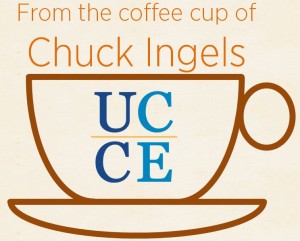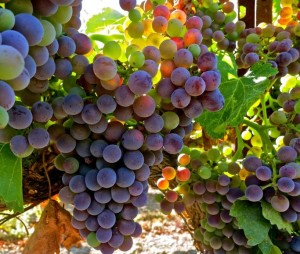 There’s nothing like tending a nice crop of grapes all season, only to watch a portion of them shrivel and having to drop them before harvest. Berry shrivel has been a malady of some vineyards throughout the West Coast for many years. Several shrivel disorders may occur, and berries of each have a distinct appearance when examined closely (see the Hansen, 2013 reference).
There’s nothing like tending a nice crop of grapes all season, only to watch a portion of them shrivel and having to drop them before harvest. Berry shrivel has been a malady of some vineyards throughout the West Coast for many years. Several shrivel disorders may occur, and berries of each have a distinct appearance when examined closely (see the Hansen, 2013 reference).
Sunburn occurs with insufficient leaf cover on the west or south side only. Late season shrivel occurs just before commercial harvest, likely as water moves back into the vine from the berries, especially with delayed harvest. The rachis (the stem structure of a cluster) is healthy with this disorder. Late season shrivel may be especially pronounced in Syrah grapes. Bunch stem necrosis, also known as waterberry, initially causes black spots on pedicels (branches of the rachis that attach to berries) but often is not noticed until the entire rachis dies. It is especially prevalent in Cabernet Sauvignon in the North Coast. It usually causes increased sugar concentration in the berries.
 Sugar accumulation disorder (SAD; formerly called berry shrivel) is the most common form of shrivel. SAD causes poor berry coloration and low sugar accumulation, and is triggered after veraison. It was named sour shrivel (Suppression Of Uniform Ripening) by Dr. Bhaskar Bondada of Washington State University, which also describes the taste of SAD-affected berries. SAD fruit typically have lower pH, berry weight, and Brix compared to normally developing fruit. Berries may contain up to 70-80% less sugar than healthy berries and are often shriveled. Unlike bunch stem necrosis, the rachis remains healthy. With both diseases, berries near the cluster tips are often more affected than berries at the stem end.
Sugar accumulation disorder (SAD; formerly called berry shrivel) is the most common form of shrivel. SAD causes poor berry coloration and low sugar accumulation, and is triggered after veraison. It was named sour shrivel (Suppression Of Uniform Ripening) by Dr. Bhaskar Bondada of Washington State University, which also describes the taste of SAD-affected berries. SAD fruit typically have lower pH, berry weight, and Brix compared to normally developing fruit. Berries may contain up to 70-80% less sugar than healthy berries and are often shriveled. Unlike bunch stem necrosis, the rachis remains healthy. With both diseases, berries near the cluster tips are often more affected than berries at the stem end.
SAD occurs in many wine grape varieties, both red and white. No consistent patterns are discernible in a vineyard or a vine. In some vineyards, the whole vine may be affected, with some clusters shriveled and others not shriveled but having lower sugar and pH. In other cases, normal clusters on SAD vines may be healthy with normal sugar and pH levels. Vines affected in one year may or may not be affected the next year. Damage can range from 5% of vines to 25% or more in a given year. No pathogen has been identified, although it is possible that a pathogen may be involved. University of California experiments found that healthy buds grafted onto SAD vines developed SAD fruit; also, SAD was able to spread from grafted buds to affect an entire vine.
The causes of SAD and bunch stem necrosis are not fully understood. Studies have shown that both disorders are likely associated with death of phloem tissues in the rachis that prevents water and sugar transport into the berries, and there may be a gradual transition between the two disorders. With bunch stem necrosis, necrotic lesions result in reduced water and sugar transport into the berries. With SAD, transport is also reduced, but without the rachis dying.
No methods for control of SAD or bunch stem necrosis have been developed. A UC study showed that neither crop thinning at fruit set nor thinning the greenest clusters at veraison reduced SAD. The only strategy recommended at this time is to monitor vineyards with a history of SAD before harvest and drop affected clusters. Field studies involving Gallo and UC researchers are currently underway near Clarksburg.
References
Bondada, B. 2015. Sour shrivel management: Are we there yet? Part 1 and Part 2. PowerPoint presentation at Napa Grape Growers Sustainable Viticulture Seminar, May 6, 2015.
Hansen, M. 2013. An expensive disorder.Good Fruit Grower. Feb. 15, 2013, p. 24-25.

